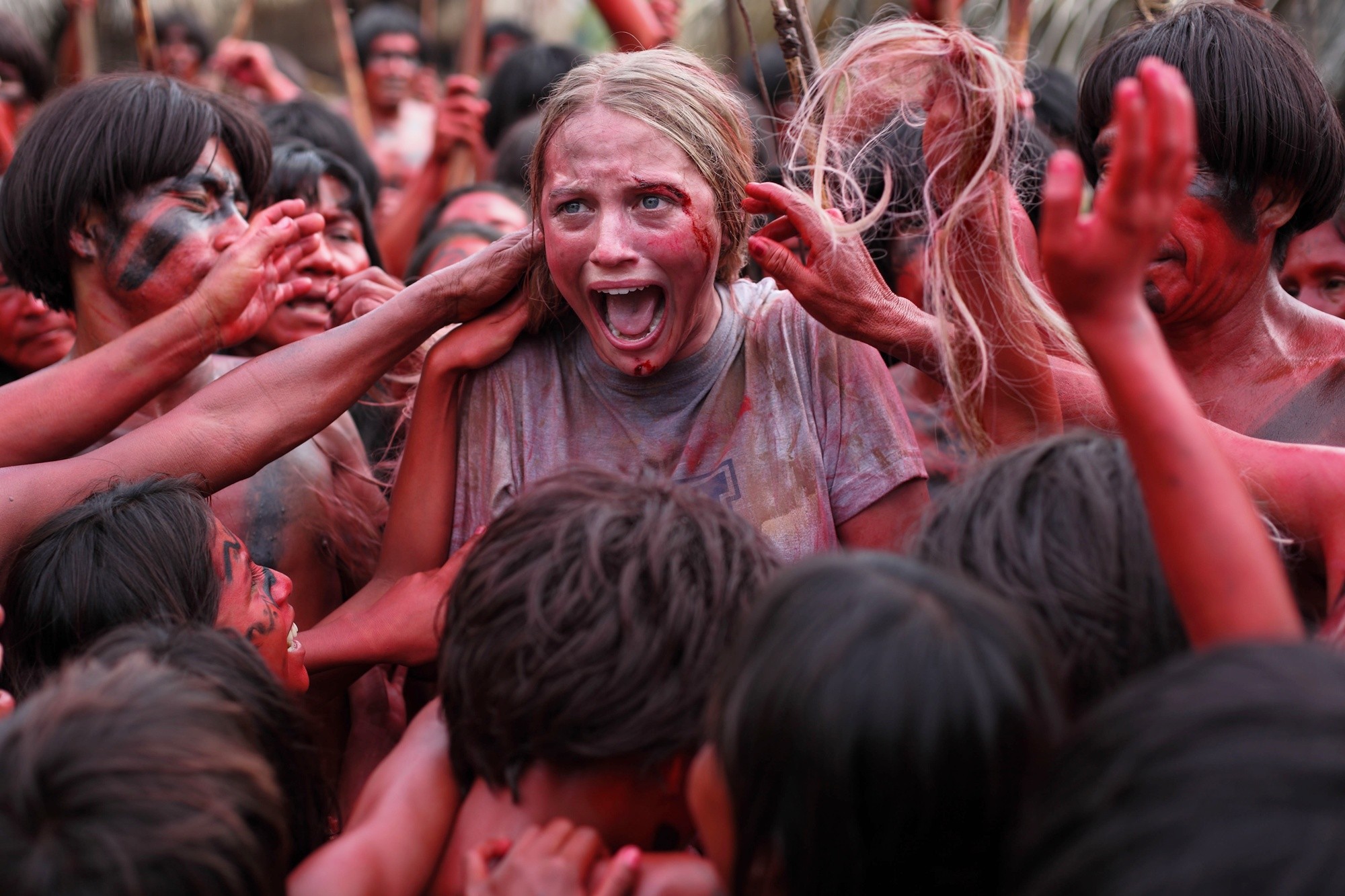THE GREEN INFERNO
 Monday, September 8, 2014 at 2:30PM
Monday, September 8, 2014 at 2:30PM Stars: Lorenza Izzo, Ariel Levy, Aaron Burns, Kirby Bliss Blanton, Magda Apanowicz, Daryl Sabara, Ignacia Allamand, Nicholas Martinez, Sky Ferreira and Antonieta Pari.
Writers: Eli Roth and Nicolas Lopez.
Director: Eli Roth.
Rating: 1.5/5

The grand-scale cannibal epic that sly marketeers have been hinting at is nowhere to be found in Eli Roth’s low-rent, low-IQ disappointment, The Green Inferno. Touted as a loving homage to Italian grindhouse hero Ruggerio Deodata’s 1980 cult shocker Cannibal Holocaust, Roth’s limp, one-note adventure plays more like a half-baked piss-take than the work of someone with any knowledge of, let alone respect for, the anthropophagus genre.
Providing the film’s only inherent worth is Lorenza Izzo as Justine, a restless freshman sharing a dorm room with her gormless bff, Kaycee (Sky Ferreira). Disgusted by a classroom presentation on female genital mutilation (surely a course requirement, though everyone acts like the images were just sprung on them), Justine is in the frame of mind to be convinced by smitten, schlubby do-gooder Jonah (Aaron Burns) to attend a campus activist group session led by the charismatic douche-bag, Alejandro (Ariel Levy).
A bat of his eyelids later and Justine is bound for South America, part of a naïve but energised group of protesters determined to highlight the region’s deforestation. A dozen nobodies padlocked to trucks and trees to spread the word about the already well-documented practices of indigenous habitat destruction seems a tad pointless, so some techno-babble about uploading the real-time confrontation for the whole world to see is inserted. In what proves to be just one of the film’s shortcomings, The Green Inferno is peopled almost entirely by imbeciles, burdened with execrable dialogue. These twenty-somethings are smart enough to be accepted into college but too dumb to research their logging industry targets before jetting off into the Amazonian jungles. “You mean, they’ll have guns?” says one wide-eyed moron, just before they board a boat to head upstream.
Long overdue action in the form of a well-staged plane crash finally spins the film on the narrative axis the target audience has been waiting for– the bloody deaths of non-essential support players and the insertion of our protagonists into unfriendly jungle. Thankfully, Roth finds some mojo and moves his players swiftly; in a whirlwind sequencing of post-crash carnage and poison darts, Justine and her surviving activists (which now include ‘Spy Kids’ alumni Daryl Sabara and pretty blonde screamer Kirby Bliss Blanton) are soon in the clutches of a red-skinned native tribe and the festivities begin.
Gorehounds will be happy that the film finally gets down to some bloodletting; by the half way mark, tongues, eyes, limbs and torsos have featured. Those new to either cannibal film lore or Roth’s gleeful depiction of acts of dismemberment will squirm, but the tone of The Green Inferno doesn’t allow for any sort of serious investment on the audiences’ part. Just as no character earns our empathy, nor do any of the acts of cannibalism prove truly shocking. It is one of several misjudgements on the productions part that creates such a chasm between it and Deodata’s film; the Italian’s camera cast an almost objective eye over the horrors, while Roth’s all but screams “Wow, look what I’m doing!”
Devolving into pointless padding (Justine’s plunge into the Amazon is entirely unwarranted) and episodic fight-or-flight diversions, The Green Inferno’s most diabolical liability is tone. Is Roth’s work a satire on spoilt rich kids and the privilege they blindly yield? Why are there passages of wacky black comedy in my cannibal movie (the ‘bag of pot’ sequence is plain stupid; it’s ‘overseas’, remember, so we gotta get a diarrhoea joke in there…)? There is meant to be humour in the notion that the traditional tribal practices the protesters are trying to save proves to be their undoing, right? So why is it barely referenced? And does the tribe (whose ‘remote outpost’ looks like a quiet corner of Central Park) exist only to prepare and eat human flesh? Little else seems to be going on for the whole time the captives are there.
Of greater interest than anything in the film would be to consider The Green Inferno as part of Roth’s broader filmography. To date, his films present the ‘uncivilised world’ as a dangerous threat to those who are privileged, collegiate, good time go-getters. His heroes aren’t always the brightest of bulbs, but they are America’s future; so far, they have been threatened by the swampy backwaters of their own homeland (Cabin Fever), the horrors of Eastern Europe (the Hostel films) and, in his latest work, the ‘savages’ of South America. In each case, powerful forces not aligned to the vision of the upwardly mobile represent pure evil (here, personified by the majestically demonic Antonieta Pari as ‘The Elder’); myopic villains driven to exploit those that represent the best the US can and will offer. There is a forceful horror at work in The Green Inferno, but perhaps it is not the flesh-eaters of the rainforest.
 amazon,
amazon,  cannibalism,
cannibalism,  eli roth,
eli roth,  green inferno,
green inferno,  horror
horror 